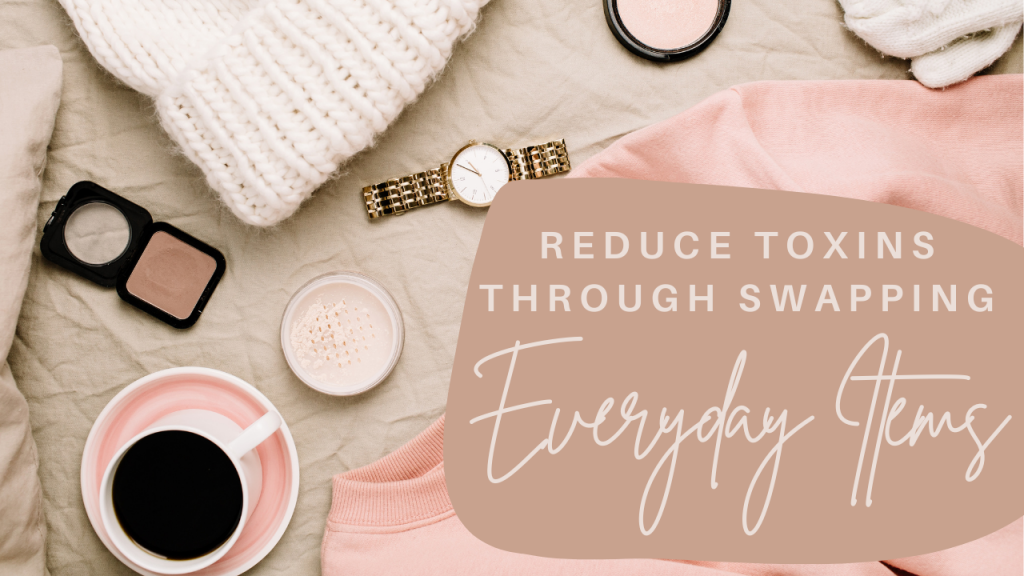
Have you ever thought about all the items you use and come in contact with on a daily basis? When I started making a list, it started with just my morning routine and the everyday items I was using on my skin and hair. At first I thought my list was pretty fantastic — very few everyday items and most of them with totally clean ingredients.
But then I realized I wasn’t covering everything. I started to think about the items I touched multiple times a day and used: towels, dishes, silverware….my sheets and mattress….suddenly it became really overwhelming. I came to the conclusion that in one single day I was using WAY more items than I realized. But that’s the world we live in, isn’t it? We have a lot of things and we use a lot of things.
After creating this little mental list of items I used on a daily basis, I can understand why there is such a shift toward reducing what we have in our homes and creating a more minimalist lifestyle. And I have to be pretty okay with what I use everyday, because over time I’ve consolidated and reduced the number of things I use.
But for me, I always like to see if there’s a way I could change what I’m doing. And the best way I know how to start with making a change is by analyzing what I’m doing currently. From there I see if there’s any places I can adjust my habits or products.
With this list of everyday items, I will also cover:
- Why everyday items are such a great place to cut toxins
- The main ways we are exposed to toxins at home
- Daily habits that will improve a healthy home
- My master list of healthy everyday items you can switch out
WHY I FOCUS ON EVERYDAY ITEMS FIRST
You might be wondering why anyone would ever make a list of everyday items they use. When I start to look at ways I can improve my life to reduce as many toxins as I can, I start to look at a few key factors. First, I look at the items that are the largest in my home. This is often things like flooring, furniture, etc. These products are large in surface area, and often have the most potential for off-gassing. But the problem is often that these items are expensive to replace and require a lot of time and planning as well.
The next thing I often look at is what I am using or coming into contact with the most throughout the day. Because there are certain products and materials that I’m exposing myself to consistently on a daily basis (or multiple times throughout the day), there is also potential for toxin exposure.
The problem with a lot of toxins is that we are coming into contact with them so often that our bodies aren’t getting a break from them. This is true of many well-known offenders like phthalates, formaldehyde and flame retardants. These toxins, when we’re constantly exposed, can build up in our systems and that’s when you start to talk about body burden. Body burden is an overloading that happens in our system and ultimately it affects big areas like our immune function and our hormone regulation. These things are what keep our bodies feeling good on a regular basis and allow us to fight off viruses and bacteria we come into contact with.

THE THREE WAYS WE ARE EXPOSED TO TOXINS AT HOME
During the day, there are three avenues in which our bodies are exposed to toxins. We can be exposed to the same type of toxin all three ways:
What goes IN our bodies: The food we eat and what we store our food in can become a way we expose ourselves to unnecessary toxins. I mentioned this a few weeks ago, but I am constantly learning SO much about food and nourishing my family in a way that incorporates whole foods and less of the unknown. I’m also learning more about how to shop for produce and meats to cut down on toxin exposure.
The plates we eat off of and the way we store our food also plays a role in the toxins we are exposing ourselves to. In some instances, warmed up plastic (either by food or by a microwave) can leave plastic toxins into the food we eat. Many plastics over time become scratched, which can then release bits of plastic into our food as well. Cooking with toxins containing pots and pans is another way we expose ourselves to unnecessary toxins.
The way we cook and store our food is oftentimes just as important as the food itself that we’ve so cautiously chosen. Ingesting toxins is a direct route to the bloodstream, where it can disperse throughout your body.
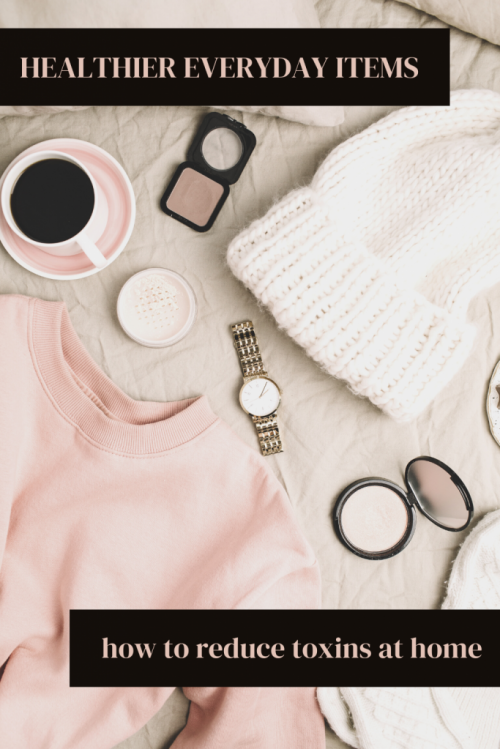
What goes ON our bodies: Our skin is our largest organ, and absorbs the products we put on it and the clothing we wear. Toxins that are absorbed by our skin are often found in beauty products, bedding, clothing and personal care products. A lot of times these are the toxins that we’re exposing ourselves to with our everyday items.
By carefully selecting laundry detergents that use clean ingredients and choosing organic clothing and bedding, you can eliminate all kinds of toxins that can be absorbed such as pesticides, fragrance toxins, and perfluorochemicals.
You can also be extremely conscious about the products you put on your skin while bathing and with daily routines. I think the clean-ingredient everyday items I use on my skin have had a huge impact on reducing the toxins that I come in contact with on a consistent basis.
I love using NakedPoppy to find clean beauty and skincare items. They take out all the guess work and curate ONLY products that are healthy and safe. (USE MY LINK TO GET AN AUTOMATIC 10% OFF)
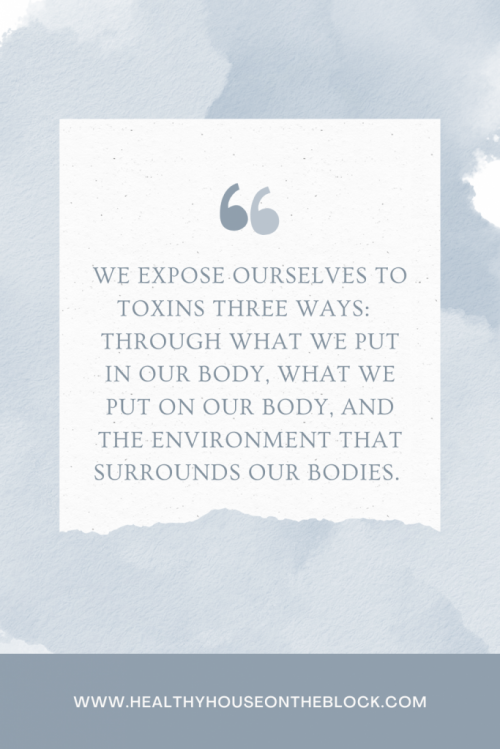
What surrounds our bodies: And then there’s the environment around us. We inhale toxic materials and products that are off-gassing constantly. Volatile Organic Compounds are everywhere, even naturally outside. But when we don’t have ways for them to escape our home, they build up and we allow them to constantly surround our bodies.
The first step is to reduce the number of toxins that are in our home and the second step is to allow ways for toxins to exit our home on a regular basis. This two-step approach will help reduce the amount of toxins that you have and that stay inside your home. It’s a really important way to reduce the toxins that surround your body.
DAILY HABITS TO PROMOTE A HEALTHY HOME
Increase Air Exchanges: Increasing the amount of air that is coming in and completely exchanging your toxin-filled indoor air is one of the best ways to improve your indoor air quality. Just a note about this, you’ll want to make sure that your outdoor air quality is safe before you open your windows.
The goal here is to allow the indoor air to be pushed outside, while we bring in fresh air at the same time. Once your home completely “exchanges” it’s indoor air with outside air, you’ve completed one air exchange. Homes used to have natural air exchanges through small cracks and leaks in the home, but our houses now are just so energy efficient, that we have to help our houses out with this one.

Reduce Humidity Levels: High humidity levels are hard on the environment in your home. It creates a perfect environment for mold and mildew, which are both toxic to our bodies and health. High humidity levels also increases the rate of off-gassing from VOCs. By lowering your indoor air’s humidity levels, you make it more difficult for mold and mildew to grow and you also stop the reproduction of dustmites (gross). And with a lower humidity level inside, between 35% – 40%, you can reduce the rate of VOCs off-gassing.
This post can help you create the perfect indoor humidity levels with some habit changes and some tools. Most of us have higher indoor humidity, and so we need to dry it out a bit at home. You can do this by avoiding overwatering plants and line drying laundry inside. Cooking with lids and running vented fans is another habit to get into when trying to lower the humidity levels indoors.

Minimize Toxic Dust: Dust has been shown to contain toxins such as flame retardants, phthalates, perfluorochemicals and pesticides. All of these toxins were created with the intent to last for a very long time. Once the tiny particles are in your house dust, they’ll be there until you remove them.
By creating a plan to not only prevent dust from getting in, but also a plan to remove unwanted dust inside our homes, you can reduce a WHOLE LOT of toxins. To avoid toxic dust, create a no-shoe policy inside your home. This will help with toxins being tracked inside. You can also get into a habit of dusting on a regular basis. Dusting your home’s surfaces with a damp cloth, using a vacuum with a HEPA filter and wet mopping your floors are all ways that you can get rid of dust at home.
Also, be sure to change your HVAC filters on a regular basis. You can set a reminder on your phone or calendar to make sure it doesn’t get missed. Second, you can make sure that you have filters on hand at all times. I buy a box of our filters and keep them by our furnace.
Finally, you can utilize an air purifier to help reduce particles in the air and filter out toxins. I absolutely love MedifyAir and their air purifying filter system. You can use my code HHOTB15 for $15 off your purchase.
THE MASTER LIST OF HEALTHY SWAPS
I think the best way to start thinking about everyday items you might use in your home is to literally go through your day and make a few notes. I know when I did this I was SO surprised at just how many everyday items I use. But rather than get overwhelmed with the number of everyday items on your list, remember that these are ALL ways you can reduce toxin exposure and make healthy swaps. It’s empowering to know that you have complete control over the everyday items you and your family use.
You can download my checklist of specific everyday items here.
Download Your Master Checklist to Help You Start Eliminating Toxins
Share this:
- Click to share on Facebook (Opens in new window) Facebook
- Click to share on LinkedIn (Opens in new window) LinkedIn
- Click to share on Reddit (Opens in new window) Reddit
- Click to share on Pinterest (Opens in new window) Pinterest
- Click to print (Opens in new window) Print
- Click to share on X (Opens in new window) X


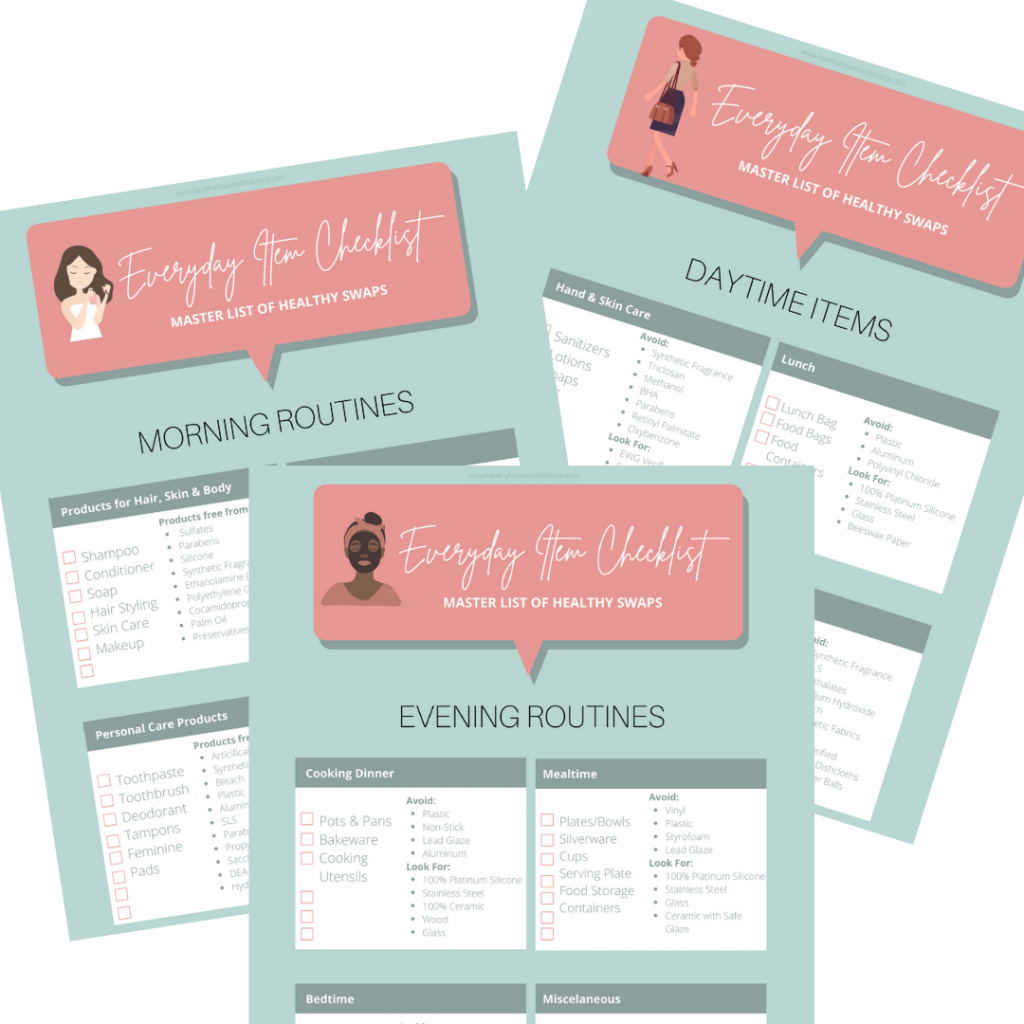
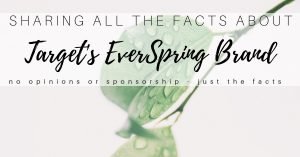


Pingback: Healthy Home Resources for 2021 » Healthy House on the Block